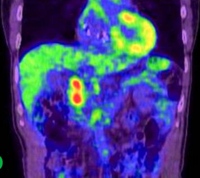Remnant Pancreatectomy for Recurrent or Metachronous Pancreatic Carcinoma Detected by FDG-PET: Two Case Reports
Abstract
Context Although surgical resection is the only curative therapeutic option for recurrent or metachronous pancreatic carcinomas, most such cancers are beyond surgical curability. We herein report on two rare cases of remnant pancreatectomy used to treat recurrent or metachronous pancreatic carcinomas. Case reports Case#1 A 65-year-old male developed weight loss and diabetes mellitus 83 months after a pylorus-preserving pancreaticoduodenectomy followed by two years of adjuvant chemotherapy (5-fluorouracil plus leucovorin plus mitomycin C) for a pancreatic carcinoma in the head of the pancreas (stage IA). An abdominal CT scan revealed a 3 cm tumor in the remnant pancreas which appeared as a ‘hot’ nodule on FDG-PET. A remnant distal pancreatectomy was performed and a pancreatic carcinoma similar in profile to the primary lesion (stage IIB) was confirmed pathologically. Case#2 A 67-year-old male showed increased CA 19-9 levels 25 months after a distal pancreatectomy for a pancreatic carcinoma in the body of the pancreas (stage IA). An abdominal CT scan revealed a cystic lesion in the cut end of the pancreas which appeared as a ‘hot’ nodule on FDG-PET. A remnant proximal pancreatectomy with duodenectomy was performed and a metachronous pancreatic carcinoma (stage III) was confirmed pathologically. Conclusion Remnant pancreatectomy can be considered a treatment option for recurrent or metachronous pancreatic carcinomas. FDG-PET can play a key role in detecting remnant pancreatic carcinomas.
Image: FDG-PET showing a hot spot at the cut end of the pancreatic head.
Downloads
References
Dalla Valle R, Mancini C, Crafa P, Passalacqua R. Pancreatic carcinoma recurrence in the remnant pancreas after a pancreaticoduodenectomy. JOP. J Pancreas (Online) 2006; 7:473-7. [PMID 16998244] (FULL TEXT: http://www.joplink.net/prev/200609/01.html)
Takamatsu S, Ban D, Irie T, Noguchi N, Kudoh A, Nakamura N, et al. Resection of a cancer developing in the remnant pancreas after a pancreaticoduodenectomy for pancreas head cancer. J Gastrointest Surg 2005; 9:263-9. [PMID 15694823] (FULL TEXT: http://www.springerlink.com/content/8430m653755q41vp/fulltext.pdf)
Miura F, Takada T, Amano H, Yoshida M, Isaka T, Toyota N, et al. Repeated pancreatectomy after pancreatoduodenectomy. J Gastrointest Surg 2007; 11:179-86. [PMID 17390170] (FULL TEXT: http://www.springerlink.com/content/a552175510287685/fulltext.html)
Wada K, Takada T, Yasuda H, Amano H, Yoshida M. A repeated pancreatectomy in the remnant pancreas 22 months after pylorus-preserving pancreatoduodenectomy for pancreatic adenocarcinoma. J Hepatobiliary Pancreat Surg 2001; 8:174-8. [PMID 11455476] (FULL TEXT: http://www.springerlink.com/content/pkv753r7kx84nwl9/fulltext.pdf)
Eriguchi N, Aoyagi S, Imayama H, Okuda K, Hara M, Fukuda S, et al. Resectable carcinoma of the pancreatic head developing 7 years and 4 months after distal pancreatectomy for carcinoma of the pancreatic tail. J Hepatobiliary Pancreat Surg 2000; 7:316-20. [PMID 10982633] (FULL TEXT: http://www.springerlink.com/content/b2mx1kl0142mu5a8/fulltext.pdf)
Japan Pancreas Society. Pancreatic Cancer Registry Report 2007. Suizo 2007; 22:e1-425. [ISSN 1881-2805] (FULL TEXT: http://www.jstage.jst.go.jp/browse/suizo/22/6/_contents)
Yeo CJ, Cameron JL, Lillemoe KD, Sitzmann JV, Hruban RH, Goodman SN, et al. Pancreaticoduodenectomy for cancer of the head of the pancreas. 201 patients. Ann Surg 1995; 221:721-31. [PMID 7794076] FULL TEXT: http://www.ncbi.nlm.nih.gov/pmc/articles/PMC1234702/pdf/annsurg00052-0121.pdf)
Ishikawa O, Wada H, Ohigashi H, Doki Y, Yokoyama S, Noura S, et al. Postoperative cytology for drained fluid from the pancreatic bed after "curative" resection of pancreatic cancers: Does it predict both the patient's prognosis and the site of cancer recurrence? Ann Surg 2003; 238:103-10. [PMID 12832972] (FULL TEXT: http://journals.lww.com/annalsofsurgery/pages/articleviewer.aspx?year=2003&issue=07000&article=00014&type=abstract)
Sperti C, Pasquali C, Piccoli A, Pedrazzoli S. Recurrence after resection for ductal adenocarcinoma of the pancreas. World J Surg 1997; 21:195-200. [PMID 8995078] (FULL TEXT: http://www.springerlink.com/content/n7l0flr7qqqudrl2/fulltext.pdf)
Kayahara M, Nagakawa T, Ueno K, Ohta T, Takeda T, Miyazaki I. An evaluation of radical resection for pancreatic cancer based on the mode of recurrence as determined by autopsy and diagnostic imaging. Cancer 1993; 72:2118-23. [PMID 8104092] (FULL TEXT: http://www3.interscience.wiley.com/cgi-bin/fulltext/112688356/PDFSTART)
Westerdahl J, Andren-Sandberg A, Ihse I. Recurrence of exocrine pancreatic cancer-Local or hepatic? Hepatogastroenterology 1993; 40:384-7. [PMID 8406311]
Griffin JF, Smalley SR, Jewell W, Paradelo JC, Reymond RD, Hassanein RE, Evans RG. Patterns of failure after curative resection of pancreatic carcinoma. Cancer 1990; 66:56-61. [PMID 2354408] (FULL TEXT: http://www3.interscience.wiley.com/cgi-bin/fulltext/112675440/PDFSTART)
Koyama K, Okamura T, Kawabe J, Nakata B, Chung KH, Ochi H, et al. Diagnostic usefulness of FDG PET for pancreatic mass lesions. Ann Nucl Med 2001; 15:217-24. [PMID 11545191] (FULL TEXT: http://www.jsnm.org/files/paper/anm/ams153/ANM15-3-06.pdf)
Rose DM, Delbeke D, Beauchamp RD, Chapman WC, Sandler MP, Sharp KW, et al. 18Fluorodeoxyglucose-positron emission tomography in the management of patients with suspected pancreatic cancer. Ann Surg 1999; 229:729-37. [PMID 10235532] (FULL TEXT: http://journals.lww.com/annalsofsurgery/pages/articleviewer.aspx?year=1999&issue=05000&article=00016&type=abstract)
Oettle H, Post S, Neuhaus P, Gellert K, Langrehr J, Ridwelski K, et al. Adjuvant chemotherapy with gemcitabine vs. observation in patients undergoing curative-intent resection of pancreatic cancer: a randomized controlled trial. JAMA 2007; 297:267-77. [PMID 17227978] (FULL TEXT: http://jama.ama-assn.org/cgi/content/full/297/3/267)
Neoptolemos JP, Stocken DD, Friess H, Bassi C, Dunn JA, Hickey H, et al. A randomized trial of chemoradiotherapy and chemotherapy after resection of pancreatic cancer. N Engl J Med 2004; 350:1200-10. [PMID 15028824] (FULL TEXT: http://content.nejm.org/cgi/content/full/350/12/1200)

Copyright (c) 2010 Masaru Koizumi, Naohiro Sata, Naoya Kasahara, Kazue Morishima, Hideki Sasanuma, Yasunaru Sakuma, Atsushi Shimizu, Masanobu Hyodo, Yoshikazu Yasuda

This work is licensed under a Creative Commons Attribution 4.0 International License.
As a member of Publisher International Linking Association, PILA, iMedPub Group’s JOP follows the Creative Commons Attribution License and Scholars Open Access publishing policies. Journal of the Pancreas is the Council Contributor Member of Council of Science Editors (CSE) and following the CSE slogan Education, Ethics, and Evidence for Editors.